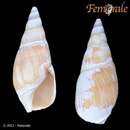en
names in breadcrumbs


Die Vingerploegskulpslak (Bullia digitalis) is 'n ongewerwelde slak wat hoofsaaklik aan die wes- en suidkus van Suid-Afrika voorkom. Die diertjie het 'n gladde, roomkleurige skulp met 'n lang, gepunte toring. Dit leef in die sanderige gebiede langs die brandersone. Die spesie versamel in groot getalle om op dooie jellievisse en bloublasies te aas.
Die Vingerploegskulpslak (Bullia digitalis) is 'n ongewerwelde slak wat hoofsaaklik aan die wes- en suidkus van Suid-Afrika voorkom. Die diertjie het 'n gladde, roomkleurige skulp met 'n lang, gepunte toring. Dit leef in die sanderige gebiede langs die brandersone. Die spesie versamel in groot getalle om op dooie jellievisse en bloublasies te aas.
Bullia digitalis, the finger plough shell or plough snail, is a species of sea snail, a marine gastropod mollusk of the family Nassariidae, the Nassa mud snails or dog whelks.[1]
These dominant scavengers are attracted by the scent of decaying animal matter from a considerable distance so that they converge from all directions to feed.
Length: 60 mm
Narrow, smooth shell with a long, pointed spire, usually light yellow or creamy, often tinged with violet or yellow.[2][3][4] The large, oval foot is offwhite.[2][4] The operculum has serrated margins.[2]
The ovate shell is elongated, subturreted, smooth and polished. It is of a reddish yellow color. The shell is composed of seven whorls, hardly convex. The suture which separates them is simple, shallow and submargined. The apex is moderately pointed. Pretty prominent striae of growth are seen upon the lowest whorl. The ovate aperture is smooth, widened at the middle and strongly emarginated at its base. The columella is yellowish, smooth and arched. A keel, continues from the upper third of the aperture to the base of the outer lip. The space between the keel and the edge of the lip is filled with oblique folds. The outer lip is simple, thin, sharp, and slightly effuse towards the middle.[5]
Lower east, south, south-west and west coast of South Africa.[3] Best viewing: Kei Mouth.[6]
Common to locally very common;[4] the dominant plough shell on Atlantic shores.[2]
Sandy beaches along the surf zone,[3] low on the shore[2] from middle tidal zone seawards where the sand is not too coarse.[4]
When the tide starts to rise, this snail emerges from the sand, spreads its large "foot" like a sail, and surfs up the beach in response to the smell of carrion.[2][3] The large foot is also used to burrow into the sand when the tide recedes.[3] Sticks its proboscis into the prey to suck up soft tissues.[3] Often gathers in large numbers to feed on dead and stranded jellyfish and bluebottles.[2][3]
Various plough shells on the southern African coast look similar, including Bullia rhodostoma on the south coast and Bullia natalensis (pleated plough shell) on the coast of KwaZulu-Natal.[4] B. digitalis however does not have pleated whorls like the pleated plough shell.[3] All the common plough shells on the coast can only de differentiated for each other by their colour.[4]
Bullia digitalis, the finger plough shell or plough snail, is a species of sea snail, a marine gastropod mollusk of the family Nassariidae, the Nassa mud snails or dog whelks.
These dominant scavengers are attracted by the scent of decaying animal matter from a considerable distance so that they converge from all directions to feed.
Bullia digitalis est une espèce d'escargot de mer d'Afrique du Sud appartenant à la famille des nassaridés[1]. C'est un charognard capable de sentir les cadavres d'une distance considérable, de sorte que beaucoup d'individus convergent vers ceux-ci pour s'en nourrir.
Sa coquille de 60 mm de long est étroite et pointue, lisse, de couleur jaune pâle ou crème, souvent teintée de violet ou de jaune[2],[3],[4]. Son grand pied ovale est blanchâtre[2],[4]. Son opercule a des marges dentelées[2].
Côtes ouest, sud-ouest, sud et sud de la côte est de l'Afrique du Sud[3]. L'espèce est facilement observée à Kei Mouth[5]. Elle est commune, localement très commune[4]. C'est le nassaridé dominant sur la côte Atlantique[2].
L'espèce vit sur les plages de sable[3] bas sur le rivage[2], dans la zone des marées, jusqu'à l'étage médiolittoral si le sable n'est pas trop grossier[4].
Lorsque la marée commence à monter, B. digitalis émerge du sable, étale son pied comme une voile et glisse avec elle sur la plage à la recherche de charognes, qu'il repère à l'odeur[2],[3]. Il utilise aussi son pied pour s'enfouir lorsque la marée redescend[3]. Il plante sa trompe dans les cadavres pour en sucer les tissus mous[3]. Ils sont souvent rassemblés en grand nombre pour se nourrir de méduses ou de physalies échouées[2],[3].
Groupe de B. digitalis mangeant le cadavre d'une méduse.
Déplacement et enfouissement d'un individu sur une plage (durée 23 secondes).
Plusieurs espèces de la côte sud-africaine lui ressemblent, notamment Bullia rhodostoma sur la côte sud et Bullia natalensis sur la côte du KwaZulu-Natal[4]. Toutes ces espèces se distinguent principalement par leurs couleurs[4].
Bullia digitalis est une espèce d'escargot de mer d'Afrique du Sud appartenant à la famille des nassaridés. C'est un charognard capable de sentir les cadavres d'une distance considérable, de sorte que beaucoup d'individus convergent vers ceux-ci pour s'en nourrir.
Bullia digitalis is een slakkensoort uit de familie van de Nassariidae.[1] De wetenschappelijke naam van de soort is voor het eerst geldig gepubliceerd in 1817 door Dillwyn.
Bronnen, noten en/of referentiesBullia digitalis, tên tiếng Anh: finger plough shell, là một loài ốc biển, là động vật thân mềm chân bụng sống ở biển thuộc họ Nassariidae.[1]
Phương tiện liên quan tới Bullia digitalis tại Wikimedia Commons
Bullia digitalis, tên tiếng Anh: finger plough shell, là một loài ốc biển, là động vật thân mềm chân bụng sống ở biển thuộc họ Nassariidae.